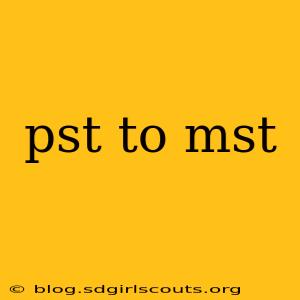Time zones can often be confusing, especially when planning events across different regions. If you've ever wondered how to convert Pacific Standard Time (PST) to Mountain Standard Time (MST), you're not alone. In this article, we'll break down the conversion process in a clear and easy-to-understand way.
Understanding Time Zones
Before we dive into the conversion, let’s understand what PST and MST are:
- Pacific Standard Time (PST): This time zone is 8 hours behind Coordinated Universal Time (UTC-8). It covers regions like California, Washington, and Oregon.
- Mountain Standard Time (MST): This time zone is 7 hours behind Coordinated Universal Time (UTC-7). It includes areas like Colorado, Utah, and Arizona.
The Difference Between PST and MST
The difference between PST and MST is 1 hour. When it’s 12:00 PM (noon) in PST, it’s already 1:00 PM in MST.
How to Convert PST to MST
Converting from PST to MST is straightforward. Here’s a simple formula:
PST to MST Conversion Formula
- Add 1 hour to PST time.
Example Conversions
Here are a few examples to illustrate the conversion:
-
Example 1: If it’s 3:00 PM PST, you simply add 1 hour.
- Conversion: 3:00 PM PST + 1 hour = 4:00 PM MST.
-
Example 2: If it’s 9:00 AM PST,
- Conversion: 9:00 AM PST + 1 hour = 10:00 AM MST.
-
Example 3: If it’s 10:30 PM PST,
- Conversion: 10:30 PM PST + 1 hour = 11:30 PM MST.
Practical Tips for Conversion
-
Use World Clocks: Many smartphones and computers allow you to set multiple clocks for different time zones. This is a great way to keep track of the time in both PST and MST simultaneously.
-
Online Tools: Various websites and apps can convert time zones quickly. Simply enter the time and select your desired time zone to get an instant conversion.
-
Avoid Daylight Saving Time Confusion: Be aware of Daylight Saving Time (DST), as it can affect the difference. During DST, PST becomes Pacific Daylight Time (PDT), which is UTC-7, and MST becomes Mountain Daylight Time (MDT), which is also UTC-6.
Conclusion
Converting PST to MST is as simple as adding one hour to your current PST time. Whether you’re scheduling a meeting, catching up with friends, or planning a call, knowing how to navigate these time zones can save you from a lot of confusion.
By utilizing tools such as world clocks or online converters, you can make sure you’re always on time—no matter where you or your contacts are located.
For further reading on time zone conversions, check out our article on Understanding Time Zones and Daylight Saving Time Adjustments.
